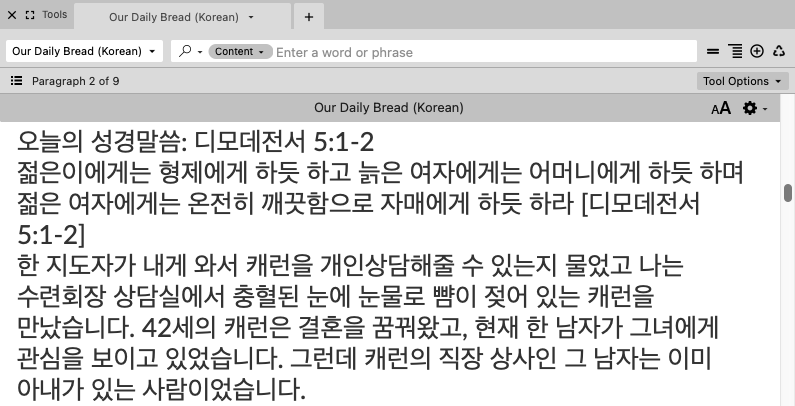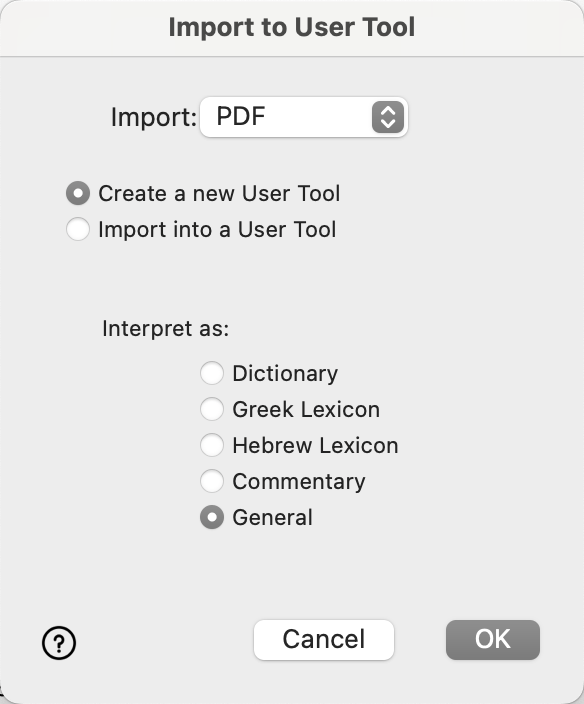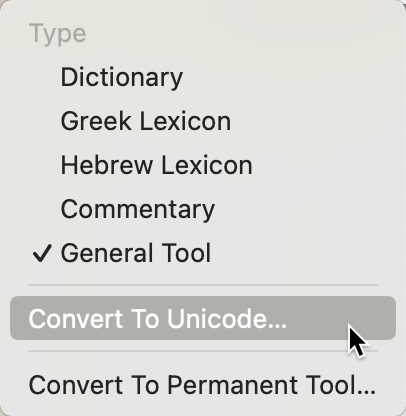Working with User Tools
User Tools are modules![]() Any Bible text, or other single tool that can be read in Accordance, including reference texts and articles; may also be referred to as content or resource that you can create and edit. They can be unicode or non-unicode. These tools can be created with a particular type, then be converted to a different one. They may be written as you work from within Accordance, or imported from files created in other software programs. In addition, multiple User Tool files can be merged into one file.
Any Bible text, or other single tool that can be read in Accordance, including reference texts and articles; may also be referred to as content or resource that you can create and edit. They can be unicode or non-unicode. These tools can be created with a particular type, then be converted to a different one. They may be written as you work from within Accordance, or imported from files created in other software programs. In addition, multiple User Tool files can be merged into one file.
Unicode Support: User Tools created in Accordance 14 now fully support Unicode fonts. This is especially useful for Accordance users working with Asian or other non-Latin languages.

User Tool Types: Accordance 14 now supports various “types” of User Tools.
- General: A regular Accordance User Tool, ideal for monographs, articles, and regular content. General User Tools are how Accordance User Tools have been structured since the feature was originally added to Accordance.
- Dictionary: A User Tool that is formatted by a topic for each heading. For example, a user could create a theological dictionary User Tool with headings on topics such as Ecclesiology, Eschatology, Covenant, etc.
- Greek Lexicon: A User Tool that is formatted by a Greek lexical form for each heading. For example, a user could create their own lexicon with headings on Greek lexical forms such as ἐκκλησία.
- Hebrew Lexicon: A User Tool that is formatted by a Hebrew lexical form for each heading. For example, a user could create their own lexicon with headings on Hebrew .גּוֹי lexical forms such as
- Commentary: A User Tool that is formatted by Scripture reference (Genesis 12:2, John 3:16, etc.). Accordance users can create their own personal commentaries with additional flexibility and content than they might add to an Accordance User Note attached to a verse.

Users can choose a User Tool type when creating a new User Tool or when importing a document into a User Tool.

Users can change an existing User Tool type by selecting the type from the Tool Options menu.

Existing User Tools can be upgraded to support Unicode font using Convert to Unicode on the Tool Options menu. User Tools that support Unicode can be converted to non-Unicode support using Convert to Non-Unicode on the Tool Options menu. The menu will only show Convert to Unicode or Convert to Non-Unicode depending on what format the current User Tool is in. It will not show both options at the same time.
Unlike the User Notes, User Tools are not directly linked to the Bible text verse by verse, although you can insert links to Scripture references. User Tools function like a General tool in Accordance and are displayed in a User Tool tab. They can be opened, searched, and accessed from the Library or Amplify![]() To select words or a reference and search for the selection in the text or tool of your choice. You can select the resource in the Library or Amplify menus. A triple-click is a shortcut which amplifies to the top tool of the relevant category. menu, like any other Accordance module
To select words or a reference and search for the selection in the text or tool of your choice. You can select the resource in the Library or Amplify menus. A triple-click is a shortcut which amplifies to the top tool of the relevant category. menu, like any other Accordance module![]() Any Bible text, or other single tool that can be read in Accordance, including reference texts and articles; may also be referred to as content or resource.
Any Bible text, or other single tool that can be read in Accordance, including reference texts and articles; may also be referred to as content or resource.
Once created, the User Tool can be edited and enhanced with colors and styles, images, Greek, Hebrew, transliteration, other type of languages, titles, and links to Scripture, other tools, other files, or web URLs. The User Tool tab has several fields which can be searched in the same way as regular tools. The titles also appear in the browser.
You can also convert a User Tool to a standard Tool, also known as an Imported Tool.
A sample User Tool, titled "Sample Tool," can be opened in Accordance and used to further explore this feature.
All new User Tools are unicode. All saved user tools will require Accordance 14 or above to be read due to new features
|
Caution When converting to a standard Tool, the tool will not be available for editing anymore, but it will be backed up on the hard drive. In the Unicode-non-unicode conversion, some information may be lost in the process. If unicode is needed to represent some characters, like Chinese, those characters will be lost when switching to non-unicode. |